The Texas Senate unanimously approved a two-year $308 billion budget on Monday — almost $6 billion more than the budget passed by the House.
The two chambers will have to negotiate the differences between their 2024-25 spending plans in order for Texas to have an official budget.
Lt. Gov. Dan Patrick described the Senate’s unanimous approval of the spending proposal as “bipartisanship at its finest.”
The budget allocates $16.5 billion for property tax relief.
As reported by The Dallas Express, property tax reductions are one of the highest priorities for Dallas voters. At the same time, Dallas residents have experienced the highest property tax increases of any major U.S. city since 2016.
The Senate’s spending plan also earmarks $10 billion for building new electricity-generating facilities and $4.6 billion for border security.
The proposal includes $3.7 billion for cost-of-living adjustments for retired teachers and the addition of $900 million for mental health services.
Legislators also approved spending $650 million on community college funding and $650 million on school security.
“We have a comprehensive approach to school safety that we’re addressing,” said Texas Senator Brandon Creighton (R-Conroe), chair of the Senate Education Committee.
“When the plane has landed at the end of this session, it’s going to be a model for this nation,” he continued, per The Texas Tribune.
The budget also prohibits using taxpayer money to fund Diversity, Equity, and Inclusion (DEI) programs at public universities.
Senator Joan Huffman (R-Houston) added that the spending proposal includes $142.1 billion in the state’s general fund.
Huffman, who serves as chair of the Senate Finance Committee, said, “We are seeing unprecedented levels of revenue to the state,” per KERA News.
“This is a once-in-a-generation opportunity to address long-standing needs, pay down debts, make strategic investments in our state infrastructure and historic sites, and most importantly, give money back to the taxpayer,” she continued.
However, some analysts maintain that the state is spending too much taxpayer money.
Daniel Sanchez-Pinol, an economist for the Texas Public Policy Foundation, described the budget as “uncomfortably high.”
“In its current form, the All Funds spending increase totals 16.3%, while the growth of the economy is only expected to be 12.33%,” he explained to The Dallas Express. “Such a scenario sets invites a crowding-out effect, as the public sector outgrows and starts replacing private sector activity in the Texas economy.
“Moreover, the rise in public spending is greater than the increase in demand for public services (measured by population growth) and the rise in the cost of providing services (measured by inflation),” he continued. “Policymakers would do well to exercise restraint as they head into conference committee to finalize the budget and work to identify areas that can be pared back to limit spending growth.”
The next step in finalizing a budget for the state will be negotiations between the Texas Senate and the Texas House.
According to a Texas Senate press release, five members from each side will now meet and try to “hammer out the differences between the chambers.”
“Perhaps the biggest question is how to deliver tax relief,” the statement read. “Though both proposals would spend the same amount on tax cuts, the House prefers to deliver tax savings through caps on increases in home appraisal value, a proposal that Lt. Governor Dan Patrick has said won’t pass the Senate.”
May 31 is the deadline for legislators to agree on a budget.






